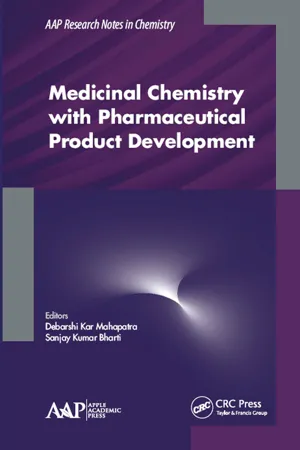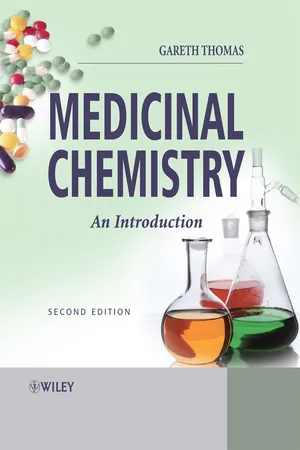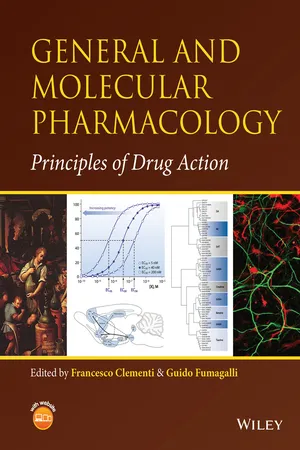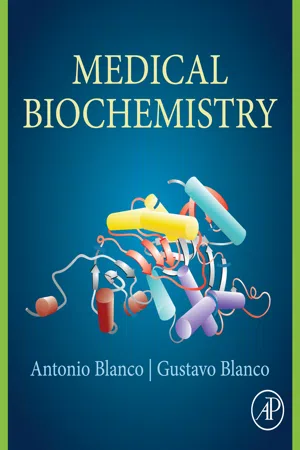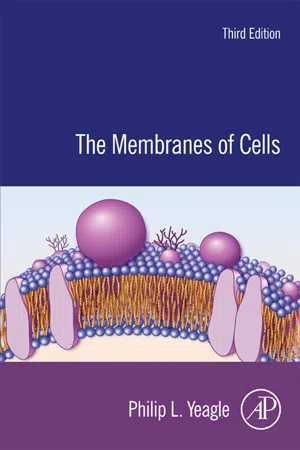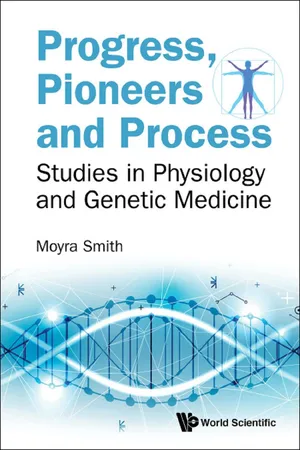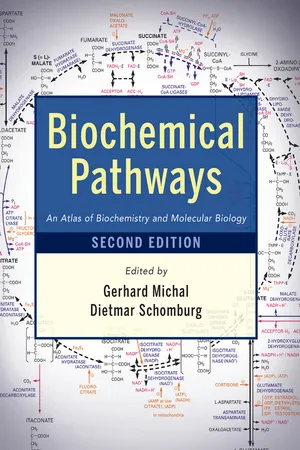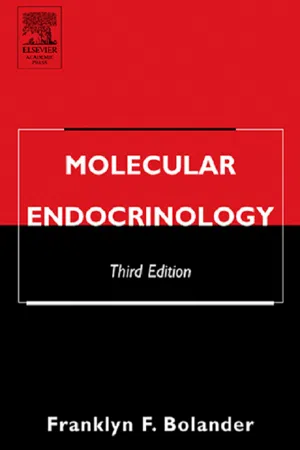Biological Sciences
Intracellular Receptors
Intracellular receptors are proteins located inside the cell that are activated by the binding of specific signaling molecules, such as hormones or neurotransmitters. Once activated, these receptors can directly influence gene expression or other cellular processes, leading to a variety of physiological responses. This mechanism allows for rapid and precise regulation of cellular functions in response to external signals.
Written by Perlego with AI-assistance
Related key terms
Related key terms
1 of 4
Related key terms
1 of 3
10 Key excerpts on "Intracellular Receptors"
- Debarshi Kar Mahapatra, Sanjay Kumar Bharti, Debarshi Kar Mahapatra, Sanjay Kumar Bharti(Authors)
- 2019(Publication Date)
- Apple Academic Press(Publisher)
4 receptor and acetylcholine receptor (AChR) has role in the treatment of Alzheimer’s disease (AD), N-methyl-D-aspartate receptor (NMDAR) is a stimuli for neuroautoimmune disorder, dopamine receptor (DAR) improves the stimulants in the treatment of Parkinson’s disease (PD), cannabinoid (CB1 and CB2) receptor in the brain, and are involved in a variety of physiological processes including appetite, pain-sensation, mood, and memory. Adenosine receptor (AR) on erythrocytes reduces the HbS oxygen affinity and promotes its polymerization and red blood cell sickling. Chemokine receptors are cytokine receptor that interacts with the leukocyte cells on the surface. Another category of receptor involves receptor tyrosine kinases (RTKs) are the high-affinity cell surface receptors for many polypeptide growth factors, cytokines, and hormones, that phosphorylates the cascades of the various signaling pathways. The transforming growth factor-β (TGF-β) system signals via protein kinase receptors and regulates the biological processes, including morphogenesis, embryonic development, adult stem cells differentiation, immune regulation, wound healing, or inflammation. Signaling through platelet-derived growth factor (PDGF) receptors contribute to multiple tumors associated processes. The ErbB/HER protein-tyrosine kinases, which include the epidermal growth factor receptor, are associated with the development of neurodegenerative diseases, such as multiple sclerosis and Alzheimer’s disease. Insulin receptor (IR) plays a key role in glucose homeostasis. Among other receptors in plants, one of them is receptor-like kinases (RLKs) which control a wide range of processes, including development, disease resistance, hormone perception, and self-incompatibility in plants. Toll-like receptors (TLRs) are non-catalytic receptors expressed in sentinel cells and play a key role in the innate immune response to invading pathogens. Apart from cell surface receptors, there is a nuclear receptor (NR) that regulates transcription in response to small lipophilic compounds and plays a role in every aspect of development, physiology, and disease in humans. Nuclear receptor (NR) includes estrogen (ERNR), progesterone (PRNR), androgen (ARNR), Vitamin D (VDRNR), and thyroid hormone (TRNR) receptors. In this chapter, we focus mainly on a signaling pathway of various receptors and their significance in various human ailments.1.1 INTRODUCTIONThe receptors are the protein molecule, usually found in the cells’ plasma membrane; facing extracellular (cell surface receptors), cytoplasmic (cytoplasmic receptors), or in the nucleus (nuclear receptors). The chemical signals such as hormones, cytokines, growth factors, enzyme or any ligand bind to a receptor that is triggering changes in the function of the cellular activity by means of various signaling pathways, this process is called signal transduction. There are several receptor components present in the cell and can be classified into the following categories:• G protein-coupled receptors: also known as seven transmembrane G-protein receptor that includes the receptors for several hormones and slow transmitters• Receptor tyrosine kinase and enzyme-linked receptor: plasma membrane receptors that are also enzymes. When one of these receptors is activated by its extracellular ligand, catalyzes the production of an intracellular second messenger ex: the insulin receptor• Nuclear receptors: When binding to their specific ligand (such as the hormone), alter the rate at which specific genes are transcribed and translated into cellular proteins. Steroid and thyroid hormone receptors are examples of such receptors.- eBook - ePub
Medicinal Chemistry
An Introduction
- Gareth Thomas(Author)
- 2011(Publication Date)
- Wiley(Publisher)
8 Receptors and messengers 8.1 Introduction Receptors are specific areas of certain proteins and glycoproteins that are found either embedded in cellular membranes or in the nuclei of living cells. Any endogenous or exogenous chemical agent that binds to a receptor is known as a ligand. The general region on are ceptor where a ligand binds is known as the binding domain. The binding of a ligand to are ceptor depends on the ligand having a significant part of its stereoelectronic structure complementary to that of the receptor’s stereoelectronic structure (see section 1.3). Ligands that fulfil this requirement will bind to the receptor and may cause eitherapositive or negative biological response. For example, positive responses can result in an immediate physiological response, such as the opening of an ion channel, or lead toaseries of biochemical events that may result in the release of so-called secondary messengers (see section 8.4.2), such as cyclic adenosine monophosphate (cAMP). These secondary messengers promote a sequence of biochemical events that result in an appropriate physiological response (Fig. 8.1). Alternatively, the binding of the ligand to the receptor may prevent a physiological response by either initiating the inhibition of an associated series of biological events (see section 8.4.2) or simply preventing the normal endogenous ligand from binding to a receptor. For example, β-blockers such as propranolol act by blocking the β-receptors for adrenaline. In all relevant cases, the mechanism by which any message carried by the ligand is translated through the receptor system into a tissue response is known as signal transduction. Figure 8.1 A schematic representation of some of the effects of ligands binding to receptors. The binding of Ligand A to the extracellular surface of the receptor results in the activation of a secondary messenger, which is followed by a cascade of biochemical events and the appropriate physiological response - eBook - ePub
General and Molecular Pharmacology
Principles of Drug Action
- Francesco Clementi, Guido Fumagalli, Francesco Clementi, Guido Fumagalli(Authors)
- 2015(Publication Date)
- Wiley(Publisher)
Chronic blockade of a receptor usually increases cell sensitivity to an agonist via mechanisms of receptor upregulation. In most cases, upregulation is associated with an increase in the number of receptors present on the cell surface mostly as a result of an increased expression of the receptor gene. These adaptation phenomena have clinical significance: the increased receptor number induced by chronic treatment with an antagonist results in tissue hypersensitivity when the treatment is discontinued, and in this condition, the natural agonist may induce extreme responses. Since the recovery to the original state (readaptation) takes time, a gradual discontinuation is usually recommended at the end of a chronic treatment with an antagonist. For analogy, a readaptation period is often required at the end of a chronic treatment with an agonist (see Supplement E 9.2 for more details).TAKE-HOME MESSAGE
- Communications between cells involve ligand–receptor interaction. In most but not all cases, the ligand is a diffusible compound and activation of the receptor generates a cellular response.
- According to the subcellular localization, receptors can be classified as intracellular or plasma membrane.
- Receptors for endogenous messengers can be grouped according to their molecular structure; members of a same receptor family share common strategies of signal transduction.
- Receptor responses are modulated in space and time.
- Most drugs act by binding to orthosteric sites of one or more receptors stabilizing them in active, inactive, or desensitized states or to allosteric sites modifying the receptor response to ligands.
- Drugs may modulate receptor responses by interfering with receptor activation and intracellular signal transduction pathways or by modifying traffic, localization, and number of receptors at the cell membrane.
FURTHER READING
General
- Alexander S. P. et al. (2013). The Concise Guide to Pharmacology 2013/14: Overview. British Journal of Pharmacology, 170, 1449–1458.
- Groves J.T., Kuriyan J. (2010). Molecular mechanisms in signal transduction at the membrane. Nature Structural and Molecular Biology, 17, 659–665.
- Haugh J.M. (2002). Localisation of receptor-mediated signal transduction pathways: the inside story. Molecular Interventions, 2, 293–307.
- Rosenfelt R., Devi L.A. (2010). Receptor heteromerization and drug discovery. Trends in Pharmacological Sciences, 31, 124–130.
Intracellular Receptors
- Gemain P., Staels B., Dacquet C., Spedding M., Laudet V. (2006). Overview of nomenclature of nuclear receptors. Pharmacological Reviews
- eBook - ePub
- Antonio Blanco, Gustavo Blanco(Authors)
- 2017(Publication Date)
- Academic Press(Publisher)
Chapter 25 Biochemical Basis of Endocrinology (I) Receptors and Signal Transduction Abstract Cells express receptors, which can be located inside the cell or at the plasma membrane. Intracellular Receptors can be in the nucleus and cytosol. They bind nonpolar or weakly polar molecules (steroid hormones, thyroid hormones, active metabolites of vitamin D, and retinoids), which can easily cross the cell plasma membrane. Once the hormone-receptor complex (HR) forms, it dimerizes and binds to specific DNA sequences (hormone responsive elements), modifying their transcription. Peroxisome proliferator activated receptor (PPAR) is a nuclear receptor that functions as a transcription factor. It regulates metabolic pathways and the cell cycle. Membrane receptors are localized on the cell surface. Upon ligand binding, these receptors undergo conformational changes that are transmitted to protein intermediates of a signal cascade system. They belong to different types: (1) G protein coupled receptors have seven transmembrane segments. G proteins are αβγ heterotrimers, which under basal conditions are inactive, bound to GDP. After binding of the ligand to the receptor, it interacts with a G protein causing the replacement of GDP for GTP, which frees the α-GTP subunit and allows it to activate downstream effectors. The βγ dimer can also act as an intermediate in the signaling process. (2) Tyrosine kinase coupled receptors (TK) consist of an extracellular segment with the ligand-binding site, one transmembrane helix, and a cytoplasmic portion containing kinase activity. Formation of the ligand receptor complex promotes dimerization of the receptor, activates its autophosphorylation and promotes the binding of cell signaling proteins. (3) Receptors associated with extrinsic TK are similar to the ones mentioned previously, but lack the catalytic site. They associate to tyrosine kinase when bound to the ligand - eBook - ePub
- Philip L. Yeagle(Author)
- 2016(Publication Date)
- Academic Press(Publisher)
The plasma membranes of cells separate the inside of the cells from the outside of the cells. The communication that must occur between the environment surrounding the cell and the interior of the cell must be mediated by the plasma membrane. The communication may be in response to extracellular signals from the immediate environment or from the organism as a whole.The process whereby signals external to the cell alter intracellular behavior is called signal transduction. The signals can be hormones or other molecular species that reach the cell surface, often from other parts of the same organism. In one specialized kind of communication, the signal is a photon of light.The plasma membrane components that mediate most signal transduction are receptors. Receptors in the plasma membrane are transmembrane proteins. A portion of their mass is exposed to the exterior of the cell and has binding sites for the signaling molecules or structures. In general, occupation of these binding sites by the signaling species will induce a conformational change in the structure of the receptor that is propagated through the protein to the cytoplasmic face of the receptor. These transmembrane receptors expose part of their mass to the cytoplasm. It is on that altered cytoplasmic domain that interactions occur between the receptor and cytoplasmic proteins that cascade sequential protein conformational changes into altered intracellular behavior.The field of signal transduction is very large. To gain an understanding of signal transduction in general, specific examples from several different groups of membrane receptors will be examined. Four groups of receptors will be used for this purpose. One group of receptors utilizes receptor-mediated endocytosis to carry out function. A second group of receptors signals by phosphorylation, including autophosphorylation, stimulated by extracellular signals. A third group of receptors modulates ion channels. A fourth group of receptors uses G proteins to propagate intracellular signaling by G-protein coupled receptors.15.1 LDL Receptor
Amphipathic lipids have substantial hydrophobic surfaces and are consequently not appreciably soluble in aqueous environments. Lipids are transported through the circulatory system, but not, consequently, as monomers in solution. Transport bodies, called lipoproteins, carry lipids through the blood. Four general classes of lipoproteins in mammalian systems transport lipids. The largest are chylomicrons that are built at the intestinal mucosa and carry dietary lipids mostly to the liver. Next largest of the serum lipoproteins is VLDL (very low-density lipoproteins). VLDL are secreted into circulation from liver and are catabolized in blood. One of the products of that catabolism is LDL (low-density lipoprotein), which is smaller than either chylomicrons or VLDL. LDL is the primary carrier of cholesterol in the blood. (The fourth class is HDL, the smallest of the lipoproteins and is secreted by the liver.) - eBook - ePub
Progress, Pioneers and Process
Studies in Physiology and Genetic Medicine
- Moyra Smith(Author)
- 2018(Publication Date)
- WSPC(Publisher)
Fig. 7.1 ).Receptors on outer cell membranes and on inner cell membranesInitial studies were carried out primarily on receptors located on outer cell membranes. Advances in analyses of intracellular organelles revealed the presence of receptors associated with the membranes of organelles.Purinergic receptors that bind adenosine triphosphate and other forms of adenosine and purine occur on inner cell membranes Purinergic receptors and inositol triphosphate-binding receptors occur on the endoplasmic reticulum.7.8The Phosphoinositide Pathway and Calcium SignalingMovement of calcium into cells can be triggered by electrical or neurotransmitter stimulation of specific cell surface receptors and by triggering and opening of calcium ion channels. Maintenance of the cellular concentration of calcium within defined limits is essential for a number of biological processes including metabolism, cell proliferation, muscle contraction, and neuronal function. The flow of calcium into and out of cells is critical for a number of biological processes. The flow is determined by channels and receptors, pumps, and regulatory proteins. Specific calcium reservoirs exist in cells. Inositol triphosphate (IP3) plays an important role in calcium signaling within the cells. IP3 binds to a specific receptor, the IP3 receptors located on the endoplasmic reticulum. This binding results in release of stored calcium within the endoplasmic reticulum into the cytoplasm of the cell (Berridge, 2016). - eBook - ePub
- Thomas E Schlaepfer, Charles B. Nemeroff(Authors)
- 2012(Publication Date)
- Elsevier(Publisher)
Receptors are proteins (either at the cell surface or intracellular) that bind hormone/neurotransmitters and begin the process of converting the agonist from extracellular signal to intracellular response. Generally, receptors recognize a particular hormone/neurotransmitter with great specificity and high affinity. Subsequent to the binding of their agonists, these receptors undergo a change of conformation which shifts them into an activated state.The concept of a hormone or neurotransmitter requiring a receptor in order to exert effects was established more than a century ago, first having been introduced by Langley in 1905. At that time, receptors were conceptual entities. As of this date, the molecular structure of a great many receptors has been identified and the details of their activation are beginning to be understood. For some receptors, the crystal structures have been solved (Kimura et al. 2008; , Kleinau et al. 2008 ). Receptors can also be defined as macromolecules that exhibit highly selective properties for binding neurotransmitter or hormone. The term “ligand” can refer to any molecule that binds to a receptor, while “agonist” and “antagonist” refer to, respectively, molecules that are able to activate a receptor and molecules that bind to a receptor but evoke the inactive confirmation. Some antagonists do evoke a response, and this will be discussed below. Currently, receptors have been divided into four groups (Table 2.1 ).Table 2.1 Representative classification of hormone and neurotransmitter receptorsMethods for receptor analysis
There are two primary ways to study the interaction between a hormone and its receptor. One of these methods involves a biological assay. A classical biological assay utilizes an isolated organ strip, such as the guinea pig ileum, and measures changes in both the frequency and strength of contraction of the intestinal smooth muscle in response to the presence of an agonist. Such a system allows the investigator to coordinate the dose of hormone with the strength of the response, but quantification is often imprecise.Radioligand binding
Another approach to studying receptors is through radioligand binding. Hormones, neurotransmitters, or derivatives thereof have been labeled with a variety of radioactive compounds. Small amounts of membrane at intact cells can be assayed for their ability to bind these radioactive drugs. The radioactive compounds can be either agonist or antagonist, and through the use of these compounds a quantitation of both the number of receptors and the affinity of those receptors for the drug can be determined. - eBook - ePub
Biochemical Pathways
An Atlas of Biochemistry and Molecular Biology
- Gerhard Michal, Dietmar Schomburg, Gerhard Michal, Dietmar Schomburg(Authors)
- 2013(Publication Date)
- Wiley(Publisher)
Although steroid (3.5.4) and thyroid (3.2.7.5) hormones, retinoids (3.5.3, 3.7.1) and vitamin D (3.7.11) are structurally very different, they all represent small, hydrophobic molecules. For transport in blood, this type of hormone has to be bound to protein carriers. Since in this way they remain in the circulation for extended periods of time (hours to days), their action is long-lasting.Once released from their carrier protein, the hydrophobicity of these hormones enables them to simply diffuse across the cytoplasmatic membrane. Contrary to other hormones, they bind and activate their cognate receptors intracellularly. The receptor/hormone complexes formed in the cytosol then translocate to the nucleus and bind to specific hormone response elements (HRE) on DNA, where they act directly as enhancers (or sometimes also as repressors) of transcription (4.2.1).These receptors share a common structure principle (Fig. 7.7-1 ) and constitute the superfamily of nuclear hormone receptors (48 known human members).Figure 7.7-1 General Structure of Nuclear ReceptorsGenerally, these receptors consist of a C-terminal hormone binding and dimerization domain (E) that is connected via a hinge region (D) with a DNA binding domain (C, containing 2 Cys2 -Cys2 zinc fingers, Table 4.2.2-1 ) and an N-terminal transcription activating domain (A/B). The DNA binding and a good portion of the dimerization domains are highly conserved, while the transcriptional activation domains differ greatly between receptors. Two receptor groups are to be distinguished (Table 7.7-1 , Fig. 7.7-2 ):- Group A receptors:
- eBook - ePub
- Franklyn F. Bolander(Author)
- 2004(Publication Date)
- Academic Press(Publisher)
Lipophilic hormones have no problem traversing the plasma membrane. Their receptors are soluble cellular proteins that function as ligand-regulated transcription factors. Hydrophilic hormones cannot cross the plasmalemma and must interact with the cell at its surface. Because their receptors are membrane bound, a second messenger must be generated to carry the signal deeper into the cell. These receptors recruit many local molecules for this job: membrane phospholipids, calcium, and membrane enzymes such as adenylate cyclase. Finally, most of these transduction pathways involve protein kinases because phosphorylation is a major way to regulate protein function.ReferencesBolander F.F. Molecular endocrinology. Meyers RA, editor. Encyclopedia of Molecular Biology and Molecular Medicine, vol 2. VCH Publishers, Amsterdam, 1996;206-216.Conn P.M., Means A.R. Principles of Molecular Regulation. New York, New York: Humana Press, 2000.Gomperts B.D., Kramer I.M., Tatham P.E.R. Signal Transduction. Totowa, New Jersey: Academic Press; 2002.Helmreich E.J.M. The Biochemistry of Cell Signalling. San Diego, California: Oxford University Press; 2001.Krauss G. Biochemistry of Signal Transduction and Regulation, 2nd ed. Oxford, U.K.: Wiley-VHC; 2001.Pufall M.A., Graves B.J. Autoinhibitory domains: Modular effectors of cellular regulation. Annu. Rev. Cell Dev. Biol. 2002;18:421-462.Weintraub B.D., editor. Molecular Endocrinology: Basic Concepts and Clinical Correlations. Weinheim, Germany: Raven Press, 1995.Passage contains an image
Chapter 5 KineticsReceptor AssaysScatchard Analysis AssumptionsKineticsIodinationMembrane Receptors Nuclear ReceptorsReceptor PreparationsSummaryReferencesThe first step in the action of a hormone is its interaction with a specific binding protein in or on the target cell; such a protein is called a receptor. This chapter describes the basic characteristics of these receptors and how to determine their number and affinity. The structure, function, and metabolism of the better-known receptors are discussed in the ensuing chapters; nuclear receptors are covered in Chapter 6 and membrane receptors in Chapter 7 . Finally, mechanisms for the regulation of receptor activity are presented in Chapter 8 - Randy W. Beck(Author)
- 2011(Publication Date)
- Churchill Livingstone(Publisher)
- • Gene regulatory proteins or transcription factors are activated in the cytosol by second messengers and secondary effectors. This follows the activation of membrane receptors by neurotransmitters and peptides, and changes to intracellular ion concentrations.
- • Immediate early gene responses can occur within nanoseconds of cell activation and represent a learned response of the cell. They can lead to protein synthesis or activation, and can also trigger transcription within the nucleus of the cell.
- • DNA code is transcribed to produce a single mRNA molecule, which then leaves the nucleus via nuclear pores.
- • mRNA passes this code to a ribosome, with the help of rRNA, which reads the base-sequence of the mRNA and translates the code into an amino acid sequence.
- • tRNA transfers the appropriate amino acids in the cytosol to their designated site in the sequence being formed by the rRNA.
Some signalling molecules such as hydrophobic hormones (glucocorticoids, oestrogen, and testosterone) can gain direct access to the nuclear apparatus by their lipid-soluble chemical structure that allows them the ability to transverse the highly hydrophobic bilayered lipid plasma membrane dependent mainly on their concentration gradients. These hormones then bind with intracellular hormone receptors that carry them through the cytoplasm and across the nuclear membrane where they bind and alter the conformation of transcriptional factors (Evans & Arriza 1989 ; Lin et al. 1998 ).Other signalling molecules such as Ca++ ions gain access through specific ion channels present in the neuron plasma membrane (Hess 1990 ).Protein hormones, growth factors, peptide neuromodulators, and neurotransmitters must act on their transcription protein targets indirectly by either inducing a change in a transmembrane protein channel related to their receptor proteins (Lester & Jahr 1990 ) or by inducing a change in linked intramembrane proteins. Changes in these linked intramembranous proteins called G-proteins eventually result in the release of intracellular ions or the generation of intracellular second messenger such as cAMP, diacylglycerol, and inositol triphosphate (Berridge & Irvine 1989 ; Huang 1989 ), which then activate directly or through other intermediates the transcription factors in the nucleus such as CREB (Fig. 3.6
Index pages curate the most relevant extracts from our library of academic textbooks. They’ve been created using an in-house natural language model (NLM), each adding context and meaning to key research topics.
Explore more topic indexes
Explore more topic indexes
1 of 6
Explore more topic indexes
1 of 4
